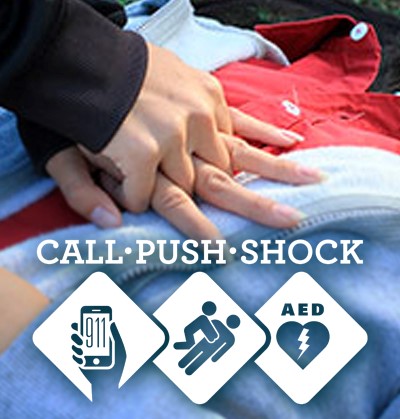
DALLAS, TX—The recovery phase following cardiac arrest continues long after hospitalization and is now included as a key link in the Chain of Survival, a widely adopted series of critical actions that work to maximize the chance of someone surviving cardiac arrest, according to the “2020 American Heart Association Guidelines for Cardiopulmonary Resuscitation (CPR) and Emergency Cardiovascular Care,” published today in the Association’s flagship journal, Circulation.
Cardiac arrest – when the heart suddenly stops beating – results in death 90%* of the time in the United States when it happens outside of the hospital setting (which is most of the time). *Updated statistic. The Association’s 2020 Guidelines provide an extensive review of evidence-based new and updated recommendations for CPR and emergency cardiovascular care training and response.
The new, sixth link in the cardiac arrest chain of survival addresses recovery. It highlights the need for treatment, surveillance and rehabilitation for cardiac arrest survivors and their caregivers.
Recommendations that are critically important to this concept include:
- structured assessment for anxiety, depression, posttraumatic stress and fatigue for cardiac arrest survivors and their caregivers;
- rehabilitation assessment and treatment for physical, neurologic, cardiopulmonary and cognitive impairments before discharge from the hospital; and
- comprehensive, multidisciplinary discharge planning for cardiac arrest survivors and their caregivers, including medical and rehabilitative treatment recommendations and return to activity/work expectations.
“The 2020 Guidelines represent a synthesis of important science that guides how resuscitation is provided for critically ill patients,” said Raina Merchant, M.D., M.S.H.P., FAHA, chair of the American Heart Association Emergency Cardiovascular Care Committee and associate professor of emergency medicine at the University of Pennsylvania. “As the science evolves over time, it’s important that we review it and make recommendations about how providers can deliver high-quality care that reflects the most updated and state-of-the-art information.”
The guidelines offer suggestions for increasing lay rescuer CPR rates, noting that currently less than 40% of non-hospitalized adults experiencing cardiac arrest receive layperson-initiated CPR before the arrival of emergency medical services. Some of the new or updated suggestions include the following:
- Raise awareness of the need for lay persons to initiate CPR for presumed cardiac arrest, underscoring that the risk of harm to the patient is low.
- Use mobile phone technology to increase the rate of bystander CPR and automated external defibrillator (AED) use. Emergency dispatch systems could alert willing bystanders via mobile phone technology apps to nearby events that may require CPR or an AED.
- Bystander CPR training should target specific socioeconomic, racial, and ethnic populations who have historically exhibited lower rates of bystander CPR. CPR training should address gender-related barriers to improve bystander CPR rates for women.
Overall, the 2020 Guidelines outline 491 recommendations specific to adult, pediatric and neonatal life support, resuscitation education science and systems of care. In addition to the updated and new written guidance, all of the algorithms were updated to reflect the latest science and several major changes were also made to improve the visual training and performance aids. Some noteworthy updates incorporating updated or new algorithms and graphics include:
- New data on respiratory rates during CPR in children are now available. The recommendation for pediatric CPR is one breath every 2 – 3 seconds (20 – 30 breaths per minute). Prior recommendations were based upon information extrapolated from adult data.
- A new chain of survival created for in-hospital cardiac arrest in infants, children and adolescents.
- A new algorithm and updated recommendations on resuscitation during pregnancy focuses on the best outcomes for both the mother and baby.
- Addressing the increase in respiratory and cardiac arrests due to opioid overdoses, two new opioid-associated emergency algorithms for lay rescuers and for trained responders.
The guidelines were last updated in 2015, at which point the process of the five-year update transitioned to an online format using a continuous evidence evaluation process rather than periodic reviews to increase the potential for more immediate transitions and updates. The 2020 Guidelines document reflects alignment with the International Liaison Committee on Resuscitation (ILCOR) and associated ILCOR member councils. The writing group notes there is limited data in some areas of resuscitation research and a need for expanded study initiatives and funding opportunities. It also lists knowledge gaps within each section of the guidelines.
“High-quality CPR can make the difference between who lives and who dies from cardiac arrest and dedicated funding and efforts are needed to ensure that everyone who needs high-quality CPR receives it,” said Merchant.
For the first time ever, the latest resuscitation science will be reflected in new high-quality CPR programs that release simultaneously, bringing science to life in the form of a new digital resuscitation portfolio. The programs are rooted in the True Adaptive™ learning design that delivers personalized instruction tailored to individual needs and knowledge levels. Developed in collaboration with Area9 Lyceum, a global leader in adaptive learning, the new digital solutions are delivered by RQI Partners, a partnership between and service provider for the Association and Laerdal Medical.
“In this time of physical distancing, resuscitation education and training delivery must evolve,” said Clive Patrickson, Ph.D. and RQI Partners’ chief executive officer. “The American Heart Association digital resuscitation portfolio uniquely and efficiently delivers safe and effective CPR quality improvement and leads healthcare organizations on an immediate journey to high-quality and verified CPR competence to maximize lifesaving outcomes. The time for digital is now.”
The guidelines were developed by the writing group on behalf of the Adult Basic and Advanced Life Support Writing Group, The Pediatric Basic and Advanced Life Support Writing Group, the Neonatal Life Support Writing Group, the Resuscitation Education Science Writing Group and the Systems of Care Writing Group.
See Executive Summary here.
SOURCE: American Heart Association
